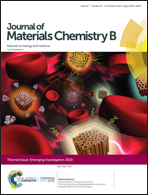Switchable modulation of bacterial growth and biofilm formation based on supramolecular tripeptide amphiphiles†
Abstract
Design and fabrication of smart supramolecular peptide systems is an effective strategy to develop antibacterial agents that can be selectively activated/inactivated by external stimuli for combating bacterial resistance. In this work, we selectively synthesized isomeric tripeptides (i.e., Ala-Gly-Gly-OH and Gly-Gly-Ala-OH) with the simplest structures to construct a minimalistic dual-responsive supramolecular antibacterial system. To impart stimuli-responsiveness, the tripeptides were modified using a hydrophobic n-butylazobenzene tail at the N-terminal, which benefited the enhancement of the hydrophobicity of the tripeptides and they served as synergistic antibacterial moieties. Two different self-assembled 1-D morphologies (i.e., nanotwists and nanofibers) were observed under the same conditions when the position of the Ala residue was altered. More importantly, the supramolecular tripeptide amphiphiles exhibited a reversible assembly/disassembly process in response to different stimuli (i.e., light and host–guest chemistry). Based on the stimuli-responsiveness, the antibacterial/antibiofilm activities against either Gram-negative or Gram-positive bacteria could be reversibly modulated.

- This article is part of the themed collection: Journal of Materials Chemistry B Emerging Investigators


 Please wait while we load your content...
Please wait while we load your content...